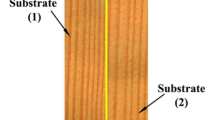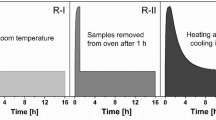Abstract
In this study, the behavior of atmospheric pressure plasma treated surfaces of Wood-Polymer Composites (WPC) was investigated as a function of time and environmental conditions. The surfaces of injection molded WPC based on polypropylene (PP) and polyethylene (PE) were treated by a dielectric barrier discharge (DBD) and subsequently aged under various conditions. The wettability as an indicator for change of the composite surface was assessed using water contact angle. In addition, a calculation for half-time of the contact angles was developed to predict the time span which is needed for recovery of hydrophobicity. The results showed a major influence of temperature and time, whereas the humidity only at storing conditions of 60 °C and 75% relative humidity showed a distinct effect on the activated surface. The effect of DBD treatment was stable for more than one week in the climates 20 °C and 0% RH and 20 °C and 65% RH.


Similar content being viewed by others

References
Akhtarkhavari A, Kortschot MT, Spelt JK (2004) Adhesion and durability of latex paint on wood fiber reinforced polyethylene. Prog Org Coat 49:33–41
Blanchard V, Blanchet P, Riedl B (2009) Surface energy modification by radiofrequency inductive and capacitive plasmas at low pressures on sugar maple: an exploratory study. Wood Fiber Sci 41:245–254
Boyd RD, Kenwright AM, Badyal JPS (1997) Atmospheric nonequilibrium plasma treatment of biaxially oriented polypropylene. Macromolecules 30:5429–5436
Fridman A (2008) Plasma Chemistry. Cambridge University Press, New York
Fritz JL, Owen MJ (1995) Hydrophobic recovery of plasma-treated polydimethylsiloxane. J Adhes 54:33–45
Gagnon DR, McCarthy TJ (1984) Polymer surface reconstruction by diffusion of organic functional groups from and to the surface. J Appl Polym Sci 29:4335–4340
Garbassi F, Morra M, Occhiello E, Barino L, Scordamaglia R (1989) Dynamics of macromolecules—a challenge for surface-analysis. Surf Interface Anal 14:585–589
Gramlich WM, Gardner DJ, Neivandt DJ (2006) Surface treatments of wood-plastic composites (WPCs) to improve adhesion. J Adhes Sci Technol 20:1873–1887
Gupta BS, Reiniati I, Laborie M-PG (2007) Surface properties and adhesion of wood fiber reinforced thermoplastic composites. Coll Surf Physicochem Eng Asp 302:388–395
Hämäläinen K, Kärki T (2013) Effects of atmospheric plasma treatment on the surface properties of Wood-Plastic Composites. Adv Mater Res 718–720:176–185
Hippler R (2001) Low temperature plasma physics: fundamental aspects and applications. Wiley-VCH, Berlin
Ikada Y, Matsunaga T, Suzuki M (1985) Overturn of polar groups on polymer surface. Nippon Kagaku Kaishi 1985:1079–1086
Kim J, Chaudhury MK, Owen MJ (2000) Hydrophobic recovery of polydimethylsiloxane elastomer exposed to partial electrical discharge. J Colloid Interf Sci 226:231–236
Kogelschatz U (2003) Dielectric-barrier discharges: their history, discharge physics, and industrial applications. Plasma Chem Plasma P 23:1–46
Kogelschatz U, Eliasson B, Egli W (1997) Dielectric-barrier discharges. Principle and applications. J Phys Iv 7:47–66
Liston EM, Martinu L, Wertheimer MR (1993) Plasma surface modification of polymers for improved adhesion: a critical review. J Adhes Sci Technol 7:1091–1127
Liu Y, Lu XY, Tao Y, Zhang YH, Di MW (2010) Plasma surface treatment of wood powder/polyethylene composites-effect of treatment time on surface characteristics of the composites. Acta Polym Sin 6:782–787
Moghadamzadeh H, Rahimi H, Asadollahzadeh M, Hemmati AR (2011) Surface treatment of wood polymer composites for adhesive bonding. Int J Adhes Adhes 31:816–821
Morra M, Occhiello E, Gila L, Garbassi F (1990) Surface dynamics vs. adhesion in oxygen plasma treated polyolefins. J Adhes 33:77–88
Oporto GS, Gardner DJ, Bernhardt G, Neivandt DJ (2007) Characterizing the mechanism of improved adhesion of modified wood plastic composite (WPC) surfaces. J Adhes Sci Technol 21:1097–1116
Owen MJ (1994) New directions in organosilicon surface science. In: Prasad PN (ed) Frontiers of polymers and advanced materials. Plenum Press, New York, pp 677–688
Owen MJ, Gentle TM, Orbeck T, Williams DE (1988) Dynamic wettability of hydrophobic polymers. In: Andrade JD (ed) Polymer surface dynamics, vol 1. Plenum Press, New York and London, pp 101–110
Podgorski L, Chevet B, Onic L, Merlin A (2000) Modification of wood wettability by plasma and corona treatments. Int J Adhes Adhes 20:103–111
Podgorski L, Bousta C, Schambourg F, Maguin J, Chevet B (2001) Surface modification of wood by plasma polymerisation. Pigment Resin Technol 31:8
Riedl B, Angel C, Pregent J, Blanchet P, Stafford L (2013) Wood surface modification by atmospheric-pressure plasma and effect on waterborne coating adhesion. Lignocellulose 2:292–306
Ström G, Fredriksson M, Stenius P (1987) Contact angles, work of adhesion, and interfacial tensions at a dissolving Hydrocarbon surface. J Colloid Interf Sci 119:352–361
Tao Y, Di MW (2011) Study on plasma treatment and adhesion of wood/polyethylene composites. Appl Mech Mater 66–68:911–915
Wolkenhauer A, Avramidis G, Hauswald E, Militz H, Viol W (2008) Plasma treatment of wood-plastic composites to enhance their adhesion properties. J Adhes Sci Technol 22:2025–2037
Wu S (1982) Polymer interface and adhesion. Marcel Dekker INC., New York and Basel
Yamakawa S, Yamamoto F, Kato Y (1976) Surface modification of polyethylene by radiation-induced grafting for adhesive bonding 2. Relationship between adhesive bond strength and surface structure. Macromolecules 9:754–758
Yasuda H (1985) Plasma polymerization. Academic Press, Inc., Orlando
Acknowledgements
This work was funded by the German Federal Ministry of Education and Research (BMBF), under the supervision of Dr.-Ing. Karen Otten, in Jülich, Germany and the joint research project “PlaNaWood” (Grant No. 03X5519A).
Author information
Authors and Affiliations
Corresponding author
Ethics declarations
Conflict of interest
The authors declare that they have no conflict of interest.
Rights and permissions
About this article
Cite this article
Hünnekens, B., Krause, A., Militz, H. et al. Hydrophobic recovery of atmospheric pressure plasma treated surfaces of Wood-Polymer Composites (WPC). Eur. J. Wood Prod. 75, 761–766 (2017). https://doi.org/10.1007/s00107-017-1175-x
Received:
Published:
Issue Date:
DOI: https://doi.org/10.1007/s00107-017-1175-x



